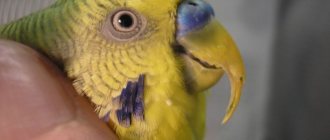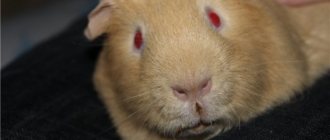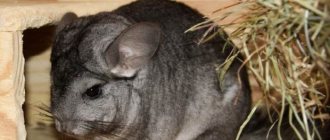A tumor is not always oncology
The diagnosis must be made by a qualified specialist in a veterinary clinic, but not everyone has the opportunity to get an appointment with a veterinarian. A preliminary conclusion can be made based on the localization of the formation:
- if the hamster has a lump on its neck, it may be an inflammation of the lymph node;
- a tumor on the abdomen in most cases is a neoplasm of the mammary gland;
- swelling of the cheek and swelling of the muzzle suggest a problem with the teeth or cheek pouches;
- swelling on the head, forehead or back may be the result of a hamster fight or other injury.
When examining the animal, you should remember the location of the marker glands in males, which are often mistaken for a sore.
In the Djungarian hamster it is located on the stomach, yellowish and covered with crusts. The Syrian hamster has two of them, symmetrically on the sides, in front of the hind legs. They look like a black oval bald spot. This is a normal anatomical formation, and there is nothing to treat here, but observation will not be superfluous: inflammation or neoplasm of the scent gland is often recorded in hamsters.
Growths in the ear are also not always a malignant tumor. In hamsters, otitis media (inflammation) of the middle ear can be accompanied by cyst-like tissue growth. In this case, the growths are filled with pus, and an unpleasant odor comes from the ears. Treatment is antibiotics locally and systemically, but otitis media often recurs again and again without being completely cured.
Hamsters can suffer from papillomatosis , a viral infection that causes the formation of dense warts of a characteristic appearance on the skin due to the accelerated growth of the epithelium. Papilloma rarely has to be removed surgically: it is a benign formation, and when the body copes with the virus, self-healing may occur.
Abscess in a hamster
As a result of fights or other injuries, purulent inflammation may occur, which looks like a limited swelling. The lump on the side may well be an abscess rather than cancer. At first it is hard and painful, and the skin is red and hot to the touch. Then the tumor softens and fluctuation appears. Hair may fall out. At the final stage, the abscess spontaneously opens and a wound appears from which pus flows.
For an abscess in a hamster, treatment involves the use of systemic antibiotics (Baytril 2.5% subcutaneously 10 mg/kg body weight). Surgical treatment of the wound is necessary: opening the abscess, cleaning the cavity and washing with an antiseptic. The wound is washed every day and protected from re-infection.
If the abscess is not treated properly, the process becomes chronic and a fistula appears, which will be difficult to heal.
Tumor on a hamster's cheek
A special case of an abscess is inflammation of the cheek pouch, the most likely reason that a hamster has a swollen cheek. Injury occurs from the inside, with a sharp object or unsuitable food: wood chips, dry pasta, seeds and nuts in shell, hay. The wound gets infected and fester occurs.
When your pet's cheek is swollen, it is better not to hesitate to visit a doctor. Purulent inflammation spreads to the surrounding tissues, and next to the cheek there are the most important structures: the eyes, ears and brain. The pain does not allow the baby to eat, and the animal quickly weakens.
If the animal's cheeks are swollen symmetrically, they should be gently massaged towards the muzzle. Then the hamster will reflexively throw out the contents of the cheek pouch, and it will be clear whether there is a problem. If the seal is preserved, the contents are checked by pulling back the edge of the lips with your hand or a stick and at the same time pressing on the cheek under the ear. This must be done while firmly holding the hamster and trying not to damage the mucous membrane.
Sometimes it makes more sense to treat a swollen cheek in a clinic setting under anesthesia. The doctor will be able to completely turn out the cheek pouch, remove foreign objects, rinse with an antiseptic (an aqueous solution of furatsilin, chlorhexidine), open the abscess and empty the cavity of pus.
When a hamster has a bump on its cheek, in addition to the cheek pouches, the doctor must check the animal’s bite.
Rodents' teeth grow throughout their lives and should be worn down normally. If this does not happen, the molars grow excessively - this is called malocclusion.
For dental problems:
- loss of appetite (or complete refusal to eat);
- discharge from the nose or swollen eye;
- abscess on the cheek, swelling.
If the length of the teeth is not adjusted, the hamster will die.
A tumor in a hamster’s neck can also indicate an inflammatory process in the oral cavity - then the nearest, “barrier” lymph node enlarges and looks like a hard lump in the area under the lower jaw. Lymph nodes also enlarge with a systemic infectious disease.
When to sound the alarm?
Few owners notice changes in the condition of their pets in the early stages of the disease. But early diagnosis is the key to a speedy recovery of the animal. How can you tell if your pet has health problems? Of course, conduct an external examination and observe the fluffy for a couple of days. You should:
- assess the animal’s activity: if Homa suddenly becomes lethargic, he is clearly unwell;
- watch your appetite. Healthy animals love to snack. If a pet refuses even its favorite treat, it is seriously ill;
- check the weight. An adult Syrian hamster must weigh at least 90 g; for all other breeds, including Djungarian hamsters, the weight must not be less than 30 g;
- examine your pet's face. The eyes should be shiny, without cloudiness or mucus. Nose – cool, without discharge. Check your ears for flaking. Pay attention to the incisors: they should grow evenly;
- make sure that there are no skin growths or tumors on the neck, armpits and abdomen;
- inspect the butt and the area of fur under the tail, they should not be wet or dirty;
- the living space also needs to be examined: if the rodent has an intestinal disorder, the stool will be liquid, and if it has cystitis or diabetes, you will understand it by the smell.
If at least one sign is detected, it is worth taking the fluffy to the veterinarian so that he can make a diagnosis and prescribe treatment.
What to do if your hamster has a swollen paw
If your pet's paw is swollen, then the first thing to suspect is a closed fracture of the hamster's paw.
An accurate diagnosis can be obtained by taking an x-ray using a good quality digital device. True, this is more of a scientific interest - neither surgery nor a cast will be performed in a veterinary clinic, only complete rest is prescribed.
What to do if your paw is swollen and the cause is unknown:
- Place in a small carrying container with solid walls without rods.
- Use paper towels instead of bedding.
- Dosed, complete feeding, monitor the presence of appetite.
- Examine the animal, checking whether a wound has appeared on its paw. Sometimes, even with open fractures, sticky hair makes it difficult to see the wound. If the animal fought with a relative, or was otherwise injured, the lump on the paw may turn out to be an abscess. Then the abscess sooner or later opens up, and it is treated like an open wound, washed daily with an antiseptic.
In the worst case scenario, the tumor on the paw turns out to be osteosarcoma . This is a malignant oncological disease that progresses rapidly and cannot be cured.
Over time, the paw is no longer visible; the entire limb is a tumor mass that spreads to the body of the animal. Osteosarcoma is more common in older animals (1-2 years).
Treatment
Certain types of fungus are treated exclusively with antifungal drugs, which should be prescribed by a specialist . Having determined the type of fungus and the degree of infection, the required dosage of the drug and course of treatment are prescribed.
Antifungal drugs:
| Triderm | Complex antifungal drug that is applied externally | The course of treatment is 10-14 days. During this period, you need to apply a thin layer of ointment to the affected areas of the skin 2 times a day. |
| Fluconazole | An antifungal drug that suppresses the synthesis of fungal spores, which should be used once a day | Course of treatment 2–4 weeks |
| Griseofulvin | Antibiotic prevents fungal cell division | The course of taking the drug is prescribed by a veterinarian |
| Ketoconazole | A broad-spectrum drug that allows you to stop the synthesis of cell membrane substances, destroying the fungal membrane | Treatment course 10 days |
How to treat at home?
First of all, it is necessary to completely isolate the sick hamster from other pets. Next, disinfect all objects with which it came into contact; if it is an inexpensive item, then it is better, of course, to throw it away completely.
Fungal spores, especially ringworm, are very persistent and can remain on the hair throughout the animal's life.
Before starting treatment, it is necessary to remove the affected hairs in those areas of the body where the disease is observed, since they are infected with fungal spores. The scissors with which you cut the hairs must be boiled for 10 minutes and treated with disinfectant. means to destroy fungal spores.
If there are crusts, they need to be softened and removed; this procedure must be done until your furry animal has fully recovered.
In addition to medications, you also need to treat the lesions with iodine solution and salicylic ointment. Thanks to the components contained in iodine, the infected surface of the skin is well disinfected, and with the help of ointment, the affected areas can be quickly restored. Also, during the treatment period, it is necessary to give your hamster special medications that support the immune system and restore the microflora.
Why does a hamster have big testicles?
After the male reaches puberty, inexperienced owners begin to sound the alarm, figuring out what to do if the hamster’s testicles are too large. But large testes relative to body size in rodents are a common occurrence. In a Syrian hamster, they become noticeable (a pair of tubercles in the lower abdomen) at the age of 2 months, and after another month the hair on them thins out and you can notice that the testicles have greatly enlarged. Hamsters can have unilateral cryptorchidism - when one testis descends into the scrotum, and the second remains in the abdominal cavity. Then the swelling in the tail area will be one-sided.
Consider the possible reasons why your hamster's testicles are swollen.
Puberty
When the animal is ready to reproduce, seminal fluid accumulates in the testes. Often, a “tumor on the butt” of a young Dzungarian male turns out to be a man’s penis of normal size.
Hormonal disbalance
Most often, when keeping males and females in the same room (but in different cages).
Inflammatory process
Red and hot skin on the testes, signs of pain are signs of infection, orchitis. Treatment is carried out with antibiotics, but not always successfully.
Oncology
There are both benign and malignant testicular tumors (seminoma). Regardless of the type of formation, the only treatment is removal of the affected organ (castration) under general anesthesia. Oncology is characterized by a one-sided lesion, in contrast to orchitis.
Scab
The causative agent of this disease is the fungus Achorion Schoenleini. Depending on the stage of development, it can look different, and has a high degree of stability in the external environment.
The incubation period of the disease ranges from several days to two weeks. As a rule, hamsters get scab in the warm season - spring and summer. The disease can be transmitted through contact with unhealthy animals and through insect bites, contaminated feed, cages, equipment, or through an owner who does not maintain hygiene.
Scab appears as a scaly white coating at the base of the ears, on the tip of the nose, on the pet’s eyebrows, and less commonly on other parts of the body. The lesions are round in shape and can reach a diameter of up to a centimeter. The affected areas become covered with gray blisters, which enlarge and then form crusts with several hairs in the center.
Scab
Treatment
Scab has characteristic external signs by which it can be distinguished from other diseases, but an accurate diagnosis will require a microscopic examination.
Sick pets must be isolated due to the highly contagious nature of the disease. Measures are required to improve sanitary and hygienic measures and ensure good ventilation of the premises. After isolating sick animals, cages, equipment, floors and adjacent surfaces are treated with disinfectants.
The affected areas of sick jungarians are cleaned of scabs and scales, previously softened with neutral fats or oils. The affected areas are treated daily until recovery with iodine tincture in equal proportions with alcohol solutions of creolin, Lysol, salicylic or picric acid, and glycerin.
Surgical intervention
If a tumor is detected in your pet, you must take a risk and agree to surgical removal. The formations in rodents grow rapidly, the skin cannot withstand it and bursts, forming a fetid, non-healing ulcer. The tumor mass prevents the animal from moving; sometimes the hamsters themselves try to chew off the foreign tissue and die from blood loss. If a limb is affected by cancer, amputation is the best option. If the tumor is on the body, it must be removed while it is still small, otherwise it will be difficult for the surgeon to close the skin defect after removal.
The use of inhalation anesthesia in recent years has increased the survival rate of rodents after surgery. The doctor must have experience working with rodents and ensure that the tiny organism does not become hypothermic during anesthesia. A starvation diet before surgery is not prescribed, and is even harmful.
Removing the tumor itself will not cure the hamster; it will remain sick and may die from tumor metastases to other organs (lungs, liver). But it can improve the quality of life.
If internal organs are affected by cancer, one can only guess about this by the symptoms or asymmetry of the abdomen. In this case, the operation does not make sense and the operation comes down to euthanasia on the surgical table.
Diseases caused by stress
Many factors contribute to stress for furbabies. Among them are sharp sounds, persecution by the cat, poor care, poor nutrition, inattention or intrusiveness of the owners. All this disrupts the hamster’s mental balance and causes serious illnesses. Their treatment should first of all be aimed at eliminating stress factors, and then at eliminating symptoms.
What do hamsters get sick with when they are stressed?
- Eczema. In autumn, the skin becomes sensitive, it peels off, wounds and sores appear, the fur seems to fade before our eyes, becomes dry and hard.
- Baldness. The wool falls out in large clumps. A specific area may become bald, or there may be islands of skin devoid of hair. Most often it occurs due to the lack of the required amount of vitamins and microelements. However, it can also be caused by simply experiencing severe stress. Therefore, at the first suspicion, make sure your pet is comfortable and eating the right diet. Externally, the problem is similar to lichen, but the skin is smooth and does not have any defects. At first, the two ailments are absolutely identical, so at the first sign, run to the doctor and find out the root cause. In this situation, you cannot rely on chance or traditional methods; it is better to take the necessary tests and get an accurate diagnosis. After all, both diseases are dangerous for the animal.
- Paralysis and heart attack. A strong sudden fright may well cause cardiac arrest, partial or complete paralysis of the furry.
Many people don’t know what to do to stop their hamster getting sick. First of all, you should think: what doesn’t your pet like? Why is he uncomfortable? We suggest you study the tips on this issue:
- do not yell at your pet or hit it under any circumstances;
- do not allow other pets near the cage;
- Do taming only a few days after acquiring the furry;
- do not force the animal to play or eat;
- monitor your hamster's diet;
- place the cage in places where there are no drafts;
- remove noisy devices from the cage;
- Clean your hamster's house more often.
As you can see, the recommendations are the simplest. But they will provide the animal with peace of mind and will not allow it to get sick from stress.
As you can see, most hamster diseases are the result of unsanitary conditions, improper care and feeding. You have the power to make the life of a funny animal interesting and comfortable, and this will increase its chances of a long and happy life without disease.











